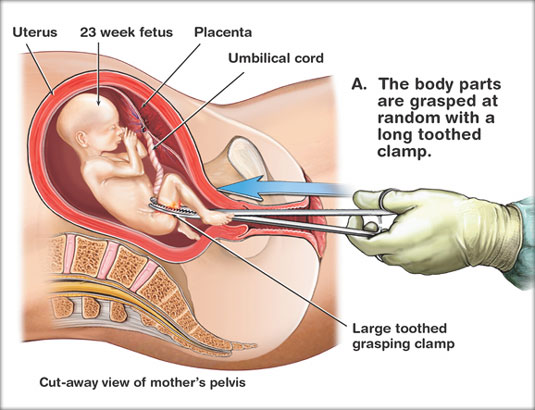DESTAQUEM, D'AQUÍ I D'ALLÀ
Partial-Birth Abortion

Click on the
illustration above to see a series of medically accurate illustrations of a
typical partial-birth abortion as performed at 24 weeks (5-1/2 months).
U.S. Supreme Court Agrees to Review Federal
Partial-Birth Abortion Ban Act
February 21, 2006
"Partial-Birth
Abortion on Trial," by Cathy Cleaver Ruse, Esq.
Shocking sworn testimony by those who
perform partial-birth abortions.
Algunes frases traduides del
document anterior:
NO és veritat que
l'anestèsia suministrada a la mare fa que el nen no senti dolor.
Aquesta forma d'avortament no és invenció dels "boixos provida", es fa
miliers i milers de vegades l'any.
A vegades el metge utilitza el dit per buidar el cervell del nen assassinat.
No sempre és necessari perforar el cap del nen, a vegades amb els forceps
s'aixafa el cap i ja està.
etc, etc, etc, ...
The Partial-Birth Abortion Ban Act -- Misconceptions and
Realities, by NRLC Legislative Director Douglas Johnson
For much more information on partial-birth abortion,
click here.
Avortament per
naixement parcial a Catalunya!!
Lo que
vio una enfermera...
En septiembre de 1993, Brenda Pratt Schaffer, una enfermera recibida con
trece años de experiencia, fue asignada por su agencia de enfermeras a una
clínica de abortos. Como ella misma se consideraba a favor de una ‘decisión
propia' [= a favor de elegir el aborto], no pensó que iba a tener algún problema
en su trabajo. Pero estaba muy equivocada.
"Estuve junto al doctor mientras hacía un aborto después de un nacimiento
parcial en una mujer que tenía seis meses de embarazo. El corazón del bebé se
veía claramente en la pantalla del ultrasonido. El doctor sacó el cuerpo y los
brazos del bebé, todo menos su pequeña cabeza. El bebé se movía. Sus pequeños
dedos se juntaban, daba de patadas. El doctor tomó unas tijeras y las encajó en
la cabeza del bebé, sus manos se desplomaron inmediatamente con una reacción de
sorpresa, como lo hace un bebé cuando cree que caerá. Entonces el doctor abrió
las tijeras y metió un tubo de succión en el hoyo de su cabeza y le sacó el
cerebro. De esta manera el bebé murió.
"Nunca regresé a esa clínica. Pero hasta hoy todavía me persigue el recuerdo
de la cara de ese bebé. Era la cara más perfecta y angelical que jamás había
visto".
Fuente: La cruz de California, agosto de 1998, p. 12.
Imatges sobre l'horror de l'infanticidi (per desmembrament) en el ventre de
la mare

La pàgina de la setmana / La página de la
semana
"(L'infant no nascut) part del cos de la mare?" / "(El niño no nacido) parte del
cuerpo de la madre?"
"(The unborn baby) part of the mother's body?"
There are a number of clear biological facts which easily
refute the claim that the embryo or fetus is simply part of the mother's body.
1) An individual's body parts all share the same genetic
code. If the unborn child were actually a part of the mother's body, the
unborn's cells would have the same genetic code as the cells of the mother. This
is not the case. Every cell of the unborn's body is genetically distinct from
every cell in the mother's body.
2) In many cases, the blood type of the unborn child is
different than the blood type of the mother. Since one body cannot function with
two different blood types, this is clearly not the mother's blood.
3) In half of all pregnancies, the unborn child is a male,
meaning that even the sex of the child is different from the mother.
4) As Randy Alcorn states in his book
Pro-Life Answers to Pro-Choice Arguments, "A Chinese zygote implanted in
a Swedish woman will always be Chinese, not Swedish, because his identity is
based on his genetic code, not that of the body in which he resides."
5) It is possible for a fetus to die while the mother
lives, and it is possible for the mother to die while the fetus lives. This
could not be true if the mother and child were simply one person.
6) It is illegal to execute a pregnant woman on death row
in the U.S. because the fetus living inside her is a distinct human being who
cannot be executed for the crimes of the mother.
7) It has long been known that unborn children play a
significant role in pacing a woman's pregnancy.
Sir Albert Lilley (the "Father of Fetology") made this observation in a 1970
speech entitled "The Termination of Pregnancy or the Extermination of the
Fetus?"
Physiologically, we must accept that the conceptus is,
in a very large measure, in charge of the pregnancy.... Biologically, at no
stage can we subscribe to the view that the fetus is a mere appendage of the
mother.... It is the embryo who stops his mother's periods and makes her womb
habitable by developing a placenta and a protective capsule of fluid for
himself. He regulates his own amniotic fluid volume and although women speak
of their waters breaking or their membranes rupturing, these structures belong
to the fetus. And finally, it is the fetus, not the mother, who decides when
labor should be initiated.
(enrere / atrás)

